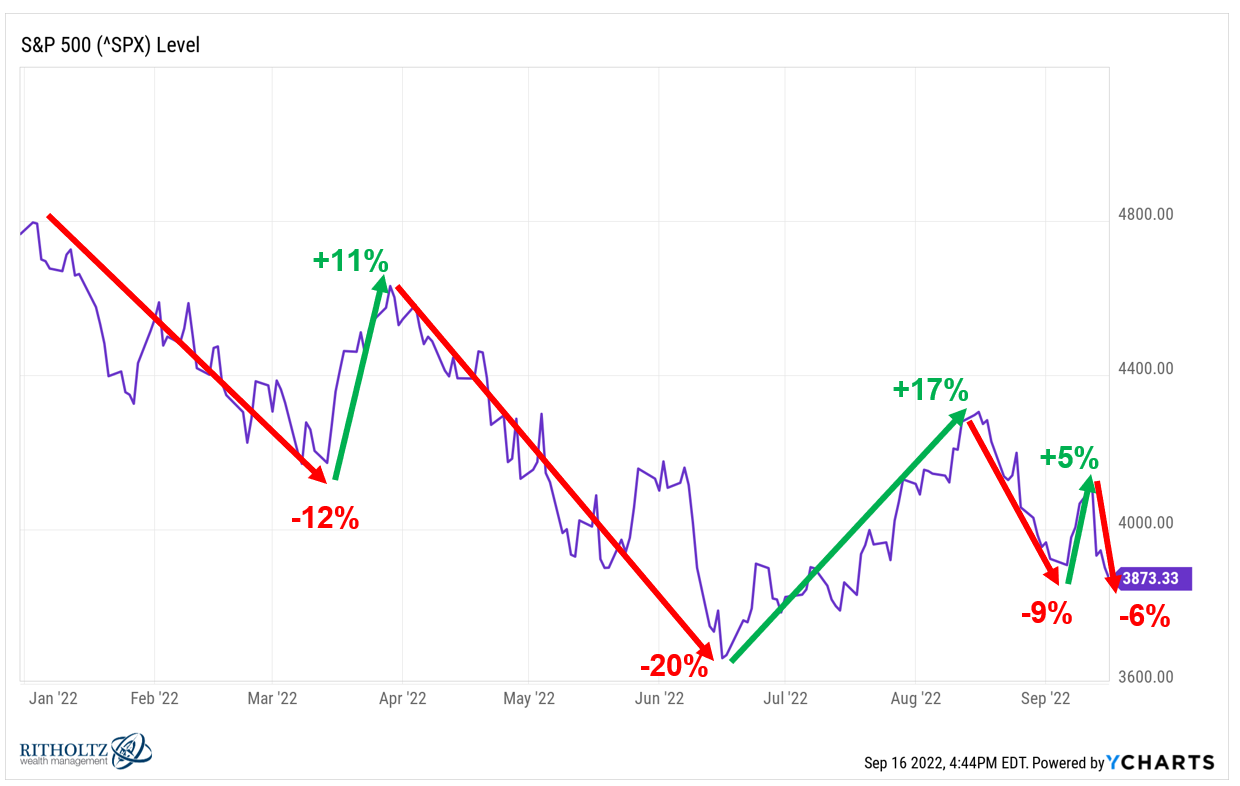On Tuesday the S&P 500 was down 4.3% after a worse-than-expected inflation reading.
It was the second time this year the market has fallen 4% or worse in a single day. Stocks have fallen 3% or worse 9 times this year and 2% or worse on 17 occasions.
The market has also gained 2% or more on 16 different trading days in 2022.
Captain Obvious would like to remind you it’s been a bumpy ride this year.
Just how bumpy you might ask?
After hitting a new all-time high on the very first trading day of the year, the S&P 500 fell 12% through early March.
From that point through the end of March, the market rallied 11%.
That brief recovery was followed by a 20% collapse through mid-June.
Mid-June remains the lows of this cycle (so far) and from that point stocks shot up 17% through the middle of August.
From there, the last month has seen moves of -9%, +5% and now another 6% down.

It feels like we’ve lived through 8 different cycles in the first 9 months of the year.
Despite all of the countertrend rallies, the prevailing trend this year is down.
This is a sea change from the previous 13 years or so when investors needed to constantly remind themselves this is a bull market you know.
Now you have to remind yourself this is a bear market you know.
I’m not sure how long the current market environment will last.
I really don’t know.
What I do know is, paying more attention to the stock market when it’s in a downtrend is not going to make your life as an investor any easier.
When the market fell more than 4% this past Tuesday I was busy at our Future Proof Festival in California.
I was so busy, in fact, that I didn’t really even notice how badly the stock market was down. I didn’t even know about it until after the market closed.1
Most days I would have been glued to the screen paying attention to what was driving the market lower. And you know what?
Me not paying attention didn’t matter!
The stock market didn’t care that I wasn’t watching. My investment plan didn’t change at all simply because there was one bad day in the stock market. It hasn’t changed because this year has been difficult.
Every financial plan has to survive difficult times in the market.
It’s also important to remember to focus on the right stuff during markets like these. And for me, that means zooming out and focusing on the long run.
In his book The Four Pillars of Investing, William Bernstein offers up one of my all-time favorite stock market analogies courtesy of Ralph Wanger, a portfolio manager from the Acorn Fund:
He likens the market to an excitable dog on a very long leash in New York City, darting randomly in every direction. The dog’s owner is walking from Columbus Circle, through Central Park, to the Metropolitan Museum. At any one moment, there is no predicting which way the pooch will lurch. But in the long run, you know he’s heading northeast at an average speed of three miles per hour. What is astonishing is that almost all of the market players, big and small, seem to have their eye on the dog, and not the owner.
The longer this volatility lasts the easier it becomes to pay too much attention to the dog and not the owner.
If you’re an accumulator of financial assets, this volatility should be viewed as an opportunity to buy at lower prices, not a risk.
If you’ve already accumulated financial assets, this volatility is the other side of a decade-plus of extraordinary gains in the U.S. stock market.
Either way, it’s important to remember that volatility — to both the upside and the downside — is a feature of bear markets.
There is nothing you can do to control that volatility.
But you do control how you react to the volatility.
Further Reading:
Stocks For the Long Run
1Operating on west coast time is bizarre when it comes to both markets and sports. You wake up and the market is already open and it’s basically closed by lunchtime. And Monday Night Football starting at dinner time was both peculiar and enticing.
